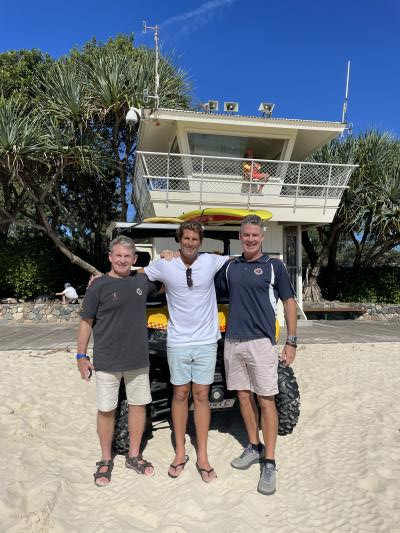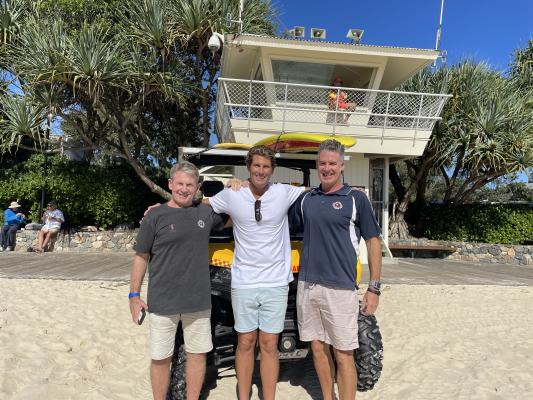
With over 5500 rescues under his belt throughout 26 years of lifeguarding, this Bondi Rescue television star is an icon to the profession.
Anthony ‘Harries’ Carroll graced the sands of Noosa on Friday, surprising guests at Noosa Surf Life Saving Club’s annual dinner, and inspiring the Noosa Next Wave youths.
During his trip he caught up with Noosa Surf Life Saving Club president Ross Fisher and Head Coach Darren Mercer, who he named a hero.
“Daz and his brother are just iconic heroes in the sport and in Australia,“ Anthony said.
“I remember seeing Darren come down this famous wave at Bondi in the Kellogg’s Nutri-Grain, and they were pretty much the face of the brand.
“I’ve met a lot of Hollywood stars, rescued Hugh Jackman’s son, and I hang out with Simon Baker a fair bit, but these guys are the real stars. Darren gave me the fundamental footsteps to create the brand I am now.“
Darren returned the kind sentiments, calling Anthony “the son of Hoff“.
“We’ve known each other for a long time and it’s great to see him up here,“ he said.
“He’s such a legend in the lifeguarding world but also just in the surfing scene and lifesaving.“
Being recognised in the street is just common nature for Anthony these days, with Bondi Rescue on air in every country in the world.
“Everyone watches the TV show and it’s quite humbling that you become famous,“ he said.
“It doesn’t really sit with me well saying we’re famous because we just do what we do.“I never thought as a kid I would go on to rescue over 5500 people. I never thought in my wildest dreams that as a kid I would go on to be a lifeguard and to be on a TV show. It’s very humbling to represent the clubs and all the lifeguards and the amazing work they do.“
As a popular tourist destination, Bondi Beach commonly reaches crowds of up to 50,000 people, and thanks to his contagious smile, Anthony is asked to take at least 80 photos a day.
“We average around 250 to 300 rescues a day with about six or seven lifeguards on the beach,“ he said.
“With the magnitude of rescues, you have to be fit in the water, and you need to keep your skills up. Fatigue levels build up because of the heat, and due to the show you also have to deal with the popularity of the lifeguards.“
Dreaming to retire in Noosa with his family, Anthony said it was one of the most beautiful places in the world.
“This is a very iconic holiday destination, very similar to that Bondi feel and people come to try and cleanse themselves,“ he said.
“This place is heaven on earth. These guys do an amazing job here. They’ve got a big influx of people that come down to the beach, so things happen down here from resuscitations to rescues, and it doesn’t matter which beach you’re on, you’ve got to bring your A game for a rescue.“
Anthony said both lifesavers and lifeguards were faced with traumatic situations.
“In my game, if a family is watching a loved one that has died on the beach, calm has to be contagious, and if you’re not calm, you’re not going to be able to do anything,“ he said.
The Covid pandemic was the toughest time throughout his career with the beaches being forced shut.
“There were three fatalities that I had to attend to within a week,“ Anthony said.
“People were really suffering with their mental health. Council did a tremendous job to help out at all ends but it was a very hard time in my career.
“It’s really important as a surf lifesaver or a lifeguard that you have the right processes in place.
“I come from a different era where it was a blokey bloke, ’you’ll be right mate’ mentality. Whereas now we get counselling. Because you look at the combative trauma after 26 years… I’ve been pulling bodies in from the age of 18 and that adds up into the hundreds. That magnitude is not met anywhere else in Australia. Any of the kids I’m with now, you have to check in. They talk a lot more and that’s a great thing.“
Working with a company in Brisbane called First Aid Kits Australia, Anthony has been endorsing first aid kits and defibrillators.
“It’s quite astonishing to know the numbers, 33,000 Australians die each year from a cardiac arrest. Getting a defibrillator on them within a minute has a 90 per cent success rate of bringing that person back to life,“ he said.
“I’ve used a defibrillator 20 to 30 times in my career and I’m just astonished at how amazing these products are at bringing people back to life. Seeing people in the streets that you’ve brought back to life is just incredible.“
Noosa Surf Life Saving Club president Ross Fisher said they were working on getting defibrillators in all of Noosa’s lifesaving towers.
Surf lifesavers are pillars of the community, Anthony said.
“They’re up early in the morning before the lifeguards get here, they’re here late at night, and they’re doing stuff that is just heroic outside of hours. You can’t beat this surf lifesaving brand.“







